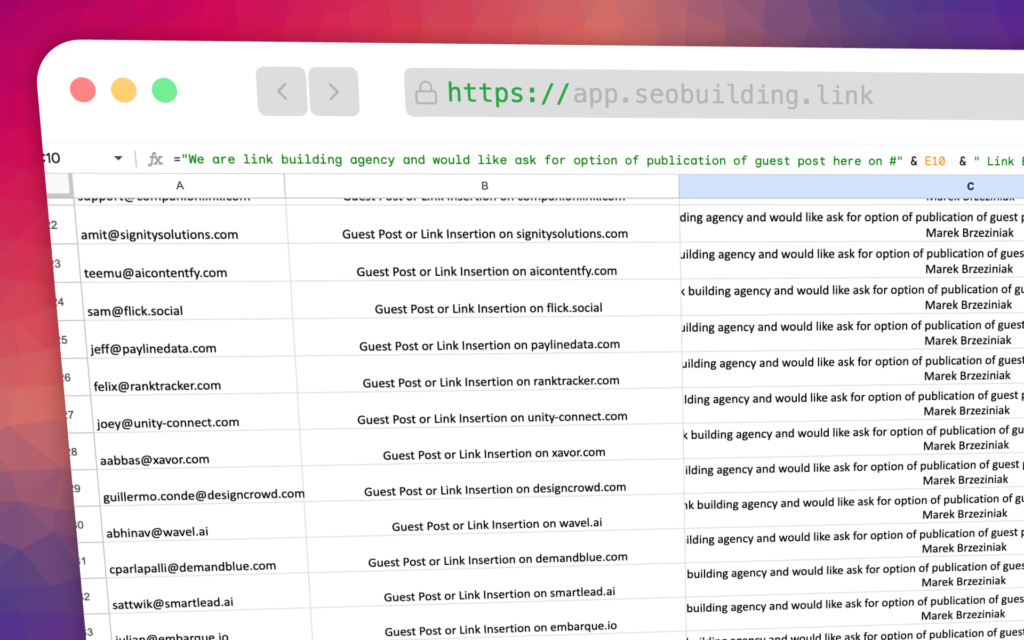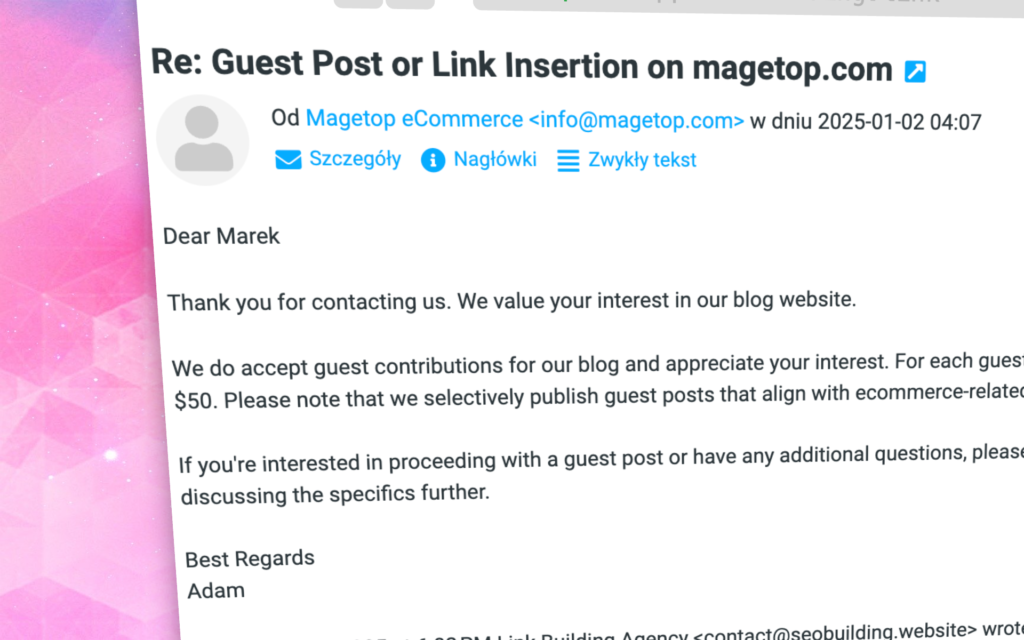
In this guide I will show you how to start SEO Outreach Strategy in 2025. We use Google Sheet, smtp.com or Zapier automation and ordinary e-mail inbox account.
1. Create a Google Sheet Template
Google Sheet Outreach Template Instructions
Step 1: Create a New Google Sheet
- Go to Google Sheets.
- Click on Blank to start a new spreadsheet.
Step 2: Set Up Your Columns Create the following column headers in the first row (A1, B1, C1, etc.):
| Column | Header Name | Description |
|---|---|---|
| A | Website Name | Name of the website or business you’re reaching out to. |
| B | Website URL | Direct URL of the website (e.g., https://example.com). |
| C | Contact Name | Name of the person you’re contacting (e.g., the webmaster, marketing manager, or content manager). |
| D | Contact Email | The email address to reach out to. |
| E | Contact Phone | Phone number (if available, optional). |
| F | Website DR | Domain Rating of the website (use a tool like Ahrefs or SEMrush to find this information). |
| G | Traffic (Monthly) | Monthly traffic to the website (you can use tools like SEMrush or Ahrefs to gather this info). |
| H | Outreach Date | The date when you initially contacted the website. |
| I | Response Status | Record the status of your outreach (e.g., No Response, Positive, Negative, Follow-up). |
| J | Follow-up Date | The date when you plan to follow up if you haven’t received a response yet. |
| K | Link Placement Status | Mark whether the link was inserted, the link is pending, or if there was no link insertion. |
| L | Notes | Any additional details or comments related to the outreach, such as special requests, specific deals, or relevant feedback from the contact person. |

2. Launch SMTP Service
Integrating SMTP.com with Google Sheets offers a streamlined approach to managing and sending emails directly from your spreadsheets. This integration automates the process of adding new contacts to your SMTP.com account, ensuring your email lists are always current and accurate. By connecting Google Sheets and SMTP.com, any new contact information entered into your spreadsheet is automatically updated in your SMTP.com contact list, eliminating manual data entry and reducing the risk of errors.
Advantages of Using SMTP.com API with Google Sheets:
- Automation of Contact Management: Automatically update your SMTP.com contact list as you add new contacts to your Google Sheets, ensuring your email campaigns reach the right audience. Smtp
- Enhanced Data Accuracy: By eliminating manual data entry, you reduce the risk of errors, ensuring that your email communications are sent to the correct recipients.
- Improved Email Deliverability: Maintaining an up-to-date and accurate contact list helps improve email deliverability, ensuring your messages reach your audience effectively.
- Time Efficiency: Automating the process of adding contacts saves time, allowing you to focus on other critical aspects of your email marketing strategy.
API Possibilities with Google Sheets:
SMTP.com offers an API that allows for seamless integration with various applications, including Google Sheets. This API enables you to programmatically manage your email sending, providing greater control and flexibility over your email campaigns. Using the SMTP.com API with Google Sheets, you can:
- Send Emails Directly from Sheets: Automate the process of sending emails to contacts listed in your Google Sheets, streamlining your communication efforts.
- Manage Email Campaigns: Create, send, and track email campaigns directly from your spreadsheets, simplifying the management of your marketing efforts.
- Monitor Email Performance: Utilize the API to retrieve analytics and performance data, allowing you to assess the effectiveness of your email campaigns and make data-driven decisions.
Effectively identifying opportunities for broken link building is a crucial step toward enhancing your website’s backlink profile. The initial step involves utilizing a variety of online tools and software specifically designed to detect broken links. Popular tools such as Ahrefs, SEMrush, and Screaming Frog SEO Spider can efficiently crawl a website and highlight links that return a 404 error or redirect to a different location. These tools not only help in finding broken links but also provide insights into the link’s context, including its relevance, authority, and traffic, enabling a more informed approach to link building.
Once broken links have been identified, it is essential to conduct a link audit. This entails reviewing the websites housing these broken links to assess their quality and relevance to your niche. Factors to consider while evaluating a site include domain authority, the quality of the content on the site, and its relevance to your target audience. Websites with higher domain authority typically hold more value in terms of link building, as they can significantly influence your own site’s SEO performance when linked back.
In addition to automated tools, manual research can also yield valuable broken link opportunities. One effective strategy is to explore competitors’ backlink profiles using tools like Moz or Majestic SEO. By identifying which sites link to your competitors but feature broken links, you can reach out with your own relevant content as a suitable replacement. Furthermore, employing customized search queries on search engines can uncover additional niche-specific websites with broken links that might not be indexed by conventional tools. In conclusion, efficiently identifying opportunities needs a blend of automated tools for detection and a manual audit to ensure relevance and quality, which together can lead to successful broken link building initiatives.
If it is to hard for you and you are not fammiliar with Google Apps – Try Zapier automation:
Send Outreach E-mails from Google Sheet
Creating an Outreach Google Sheet is a powerful way to organize and streamline outreach campaigns, especially for activities like marketing, partnerships, or content promotion. Below are a few ideas for building an effective outreach Google Sheet:
1. Contact Information Tracking
Create a simple sheet to track essential contact details for outreach purposes. This could include:
| Name | Phone | Company/Organization | Position | LinkedIn Profile | Last Contacted | Follow-Up Date | Notes | |
|---|---|---|---|---|---|---|---|---|
| John Doe | johndoe@email.com | 123-456-7890 | ABC Corp. | Marketing Lead | linkedin.com/johndoe | 01/01/2025 | 01/15/2025 | Interested in collaboration |
| Jane Smith | janesmith@email.com | 987-654-3210 | XYZ Ltd. | Content Manager | linkedin.com/janesmith | 12/15/2024 | 01/10/2025 | Need product samples for review |
- Columns: Name, Email, Company, Position, LinkedIn Profile, Last Contacted, Follow-Up Date, and Notes.
- Purpose: Organize the individuals or companies you plan to reach out to, including their contact details and any follow-up tasks.
2. Campaign Tracking
If you are managing multiple outreach campaigns, a campaign tracking sheet is essential. This can help keep track of the different stages of each campaign:
| Campaign Name | Goal | Target Audience | Start Date | End Date | Status | Success Metrics | Next Steps |
|---|---|---|---|---|---|---|---|
| January Newsletter | Promote new product | Existing customers | 01/01/2025 | 01/31/2025 | In Progress | Open Rate: 40%, Click Rate: 5% | Send follow-up email |
| Spring Collaboration | Partner with influencers | Fashion Bloggers | 02/01/2025 | 02/28/2025 | Not Started | Engagement: 50% increase | Create influencer list |
- Columns: Campaign Name, Goal, Target Audience, Start Date, End Date, Status, Success Metrics, Next Steps.
- Purpose: Track the progress of various outreach campaigns, ensuring that no steps are missed.
3. Response Tracker
An outreach campaign often involves many responses from various contacts. This sheet helps monitor who responded and what action should be taken:
| Name | Organization | Date Contacted | Response Received | Response Date | Action Needed | Follow-Up Date | Notes |
|---|---|---|---|---|---|---|---|
| John Doe | ABC Corp. | 01/01/2025 | Interested | 01/05/2025 | Schedule a meeting | 01/10/2025 | Wants more info on pricing |
| Jane Smith | XYZ Ltd. | 12/15/2024 | No Response | Send reminder email | 01/05/2025 | Email reminder sent |
- Columns: Name, Organization, Date Contacted, Response Received, Response Date, Action Needed, Follow-Up Date, and Notes.
- Purpose: Track who responded to outreach and what actions need to be taken for follow-up.
4. Content Outreach
If you’re reaching out for content placement (e.g., guest posts, backlinks, media features), this sheet helps organize your efforts:
| Website/Platform | Contact Name | Date Contacted | Type of Outreach | Response | Status | Next Step | Notes | |
|---|---|---|---|---|---|---|---|---|
| ExampleBlog.com | Alice Johnson | alice@example.com | 12/10/2024 | Guest Post Request | Interested | Waiting for Approval | Finalize article details | Wants topic suggestions |
| TechNews.com | Bob Brown | bob@technews.com | 12/12/2024 | Backlink Request | No Response | Follow-Up Needed | Send reminder email | Follow-up in 1 week |
- Columns: Website/Platform, Contact Name, Email, Date Contacted, Type of Outreach (Guest post, Backlink, etc.), Response, Status, Next Step, Notes.
- Purpose: Organize outreach related to content promotion or backlinks, including details on progress and any upcoming tasks.
5. Partnership Opportunities
If you’re looking to partner with other organizations or individuals, this sheet tracks potential partnerships:
| Partner Name | Organization | Partnership Type | Date Contacted | Response | Action Needed | Follow-Up Date | Notes |
|---|---|---|---|---|---|---|---|
| Joe’s Marketing Co | Joe’s Marketing Co | Affiliate Partnership | 12/01/2024 | Interested | Schedule a call | 01/10/2025 | Wants more details about commission |
| GreenTech Solutions | GreenTech Solutions | Joint Venture | 12/15/2024 | No Response | Send second email | 01/05/2025 | Keep following up |
- Columns: Partner Name, Organization, Partnership Type (Affiliate, Joint Venture, etc.), Date Contacted, Response, Action Needed, Follow-Up Date, Notes.
- Purpose: Keep track of potential business partners and any follow-up required.
6. Influencer Outreach
If you are collaborating with influencers, you can organize the details in this sheet:
| Influencer Name | Platform | Date Contacted | Campaign/Content Type | Response | Action Needed | Follow-Up Date | Notes | |
|---|---|---|---|---|---|---|---|---|
| Emma Adams | emma@insta.com | 01/01/2025 | Sponsored Post | Interested | Send product sample | 01/05/2025 | Request budget details | |
| Tim Green | YouTube | tim@yt.com | 12/15/2024 | Video Collaboration | No Response | Send reminder email | 01/10/2025 |
- Columns: Influencer Name, Platform (Instagram, YouTube, etc.), Email, Date Contacted, Campaign/Content Type, Response, Action Needed, Follow-Up Date, Notes.
- Purpose: Track influencer outreach for promotions or collaborations, ensuring that follow-up actions are clear.
Key Features for Better Organization:
- Conditional Formatting: Highlight important dates or actions like follow-ups and deadlines.
- Data Validation: Create drop-down lists to categorize responses (e.g., Interested, Not Interested, No Response).
- Filters: Enable filters to sort by response status, follow-up dates, or campaign type for easy navigation.
- Link to Relevant Documents: You can link to campaign materials, proposals, or contracts stored in Google Drive for quick access.
Advantages of Using Google Sheets for Outreach:
- Collaboration: Easily share the sheet with your team for real-time collaboration.
- Cloud-Based: Access your outreach information from any device with an internet connection.
- Customizable: Tailor the sheet to fit your specific needs, adding more columns for specific outreach types or metrics.
- Integration: Google Sheets integrates with other Google Apps (like Google Calendar for follow-up reminders) and third-party tools for automating tasks.
By organizing outreach efforts through a Google Sheet, you can ensure better communication, stay on top of deadlines, and effectively track your campaigns.
Final Output of E-mail Outreach
